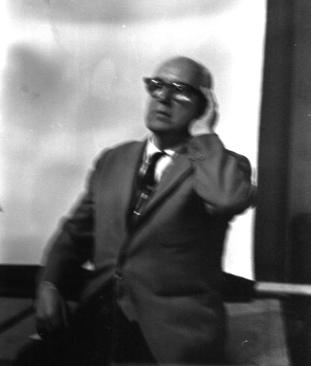Design at Southern Illinois University
that in 1927 he had taken a year off just for that. There were, he pointed out, three levels of thinking.
Brain merely registered sensations, hunger, cold, procreation. I could identify with that. Mind, he said,
enables us to make useful generalizations. The log that ancient man dragged home because he had
accidentally stood on one end and seen it lift a heavy boulder was not magic. The man's wife had
observed, "Darling, I think any log will do." Intellect enabled man to intuit scientific principles and
Fuller mentioned that he had once met Einstein. He suggested
that the ocean was not a barrier to cross, but a trillion cubic
yards of saline solution that contains all the chemical
elements to be mined.
This peppy, stocky fellow wondered how much New York's
recently completed Seagram Building weighed. A thing does
not have to be heavy to be strong, he said. He waited a while
for that to sink in. The bicycle wheel, he told us, is a perfect
balance of compression and tension and will support 300
times its weight.
Fuller told us cold warriors, some of us veterans, that we
should not worry about the Soviet nuclear threat nor the
recent launching of Sputnik. Contrary to Malthus and the
Bible, he bubbled, there were enough world resources for
everybody. The poor would not always be poor and there need
not be wars and rumors of wars. The earth could support its
growing populations if we would use mind and intellect and
begin to design, he said, beginning right here in Carbondale.
We were mesmerized. Six hours after he began, Fuller had neither sipped from his
Dixie cup nor gone to the bathroom once. We had shot all our film and our stomachs were growling for
pizza. But nobody had left the room. I was inspired by this good news, this gospel of synergy, Fuller's
term for design greater than the sum of its parts. But listening to him that day was like drinking from a
fire hose. My thirst was slaked, but much of what he had to offer shot past me. He used the word
ecology, the first time I had heard it, and peppered his talk with tensegrity and dymaxion. Then he told
us to call him "Bucky." He said he had to go to India. We went back to our drawing boards.
I was delighted some weeks later when our teachers told us the SIU had just given R. Buckminster Fuller
an honorary doctorate and made him university research professor. Great, I thought, I'd have "Bucky" as
a real teacher, giving me assignments, grading my work! But no such luck. His first professorship gave
Bucky overdue prestige but accelerated demands on his time. This week, he was off to California to
build a dome for Kaiser Aluminum.
Excitedly, I followed his adventures through rumors in the classroom and in the newspapers and
magazines. Our very own Bucky was a global force. And here we students, back in Carbondale, ran our
squeaking Magic Markers across brown paper, setting esthetics aside, redesigning the world. Because
Bucky was doing it, we knew we could do it, too.
I still believe that.
Of course, some criticized him. Some students complained that they would not get jobs with the
conceptual work we were doing. They wanted more design, so that they could build slick portfolios and
get positions with IBM. Our teachers, Elsa Kula and Davis Pratt, explained that if a school sets out to
make Indians, it produces nothing but Indians. But when it tries to produce chiefs, it still produces


A Baptist Meets Bucky - continued
By Al Gowan

photo by Dale Carlson



















